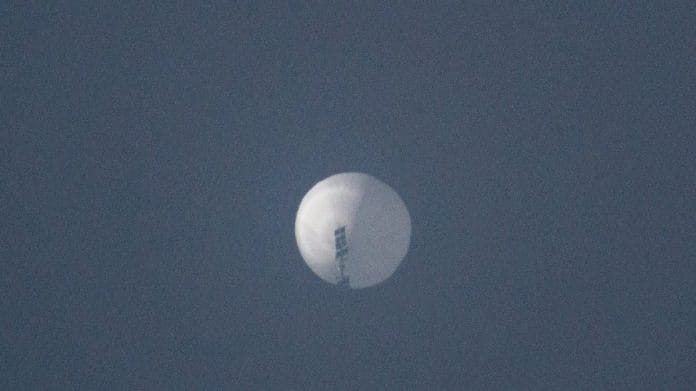Bengaluru: Chinese spy balloons have become the talk of the town ever since the Pentagon announced that it had detected one over the Northwestern part of the country on Thursday. And you can’t burst it either. Here, ThePrint explains what spy balloons are and how they work:
What is a spy balloon?
The so-called spy balloon is technically an observation balloon, and does what the name suggests — it observes earth and gathers imagery/data for intelligence.
This is not a tiny balloon, but is twice the size of popular tourist hot air balloons. Its deck holds instruments for observation, and defence forces have a history of using it for over a century.
Owing to its size, its crashing down could pose serious risk to lives and structures on the ground, which is seemingly the main reason why Biden told officials to not shoot down the Chinese one. An observation balloon is filled with Helium gas, which enables it to climb high as helium is lighter than air and is non-flammable.
Also read: Chinese ‘spy’ balloon spotted near US strategic sites not new. PRC may have used it on India
How does it differ from satellites?
An observation balloon is used for high altitude observation, and is typically thought to be no more powerful than satellites. Satellites orbit earth in the thousands and could typically gather all (and more) of the information observation balloons can gather, including military activity including weapons launches. However, the presence of balloons always raises concerns.
Balloons prove more advantageous for scientific atmospheric research than defence information gathering. They fly much lower than satellites and cannot climb higher than the thinnest layers of the atmosphere, while satellites operate in space.
However, they fly in the stratosphere, much higher than commercial aircraft. Balloons fly nearly at 30km altitude while commercial aircraft fly at around 10km. So balloons pose no risk to flights.
The highest an observation balloon has climbed was to 53km, achieved by the 34 kg-BU60-1 balloon, a test balloon developed by the Japanese Space Agency’s Instate of Space and Astronautical Science.
Observation balloons are commonly used today for research and defence purposes to gather data. Balloon use peaked during the First World War and they were also used stealthily during the Cold War. Today, there are hundreds of balloons in the stratosphere, primarily for collecting weather data.
US officials have detected such observation balloons from China over their airspace earlier. However, this is the longest any Chinese balloon has stayed over the US, prompting concern.
From China to Canada
According to Pentagon officials, the balloon travelled from China to the Aleutian Islands of Alaska, before going over to northwest Canada. It travelled over Canada for a few days and crossed the border, arriving in the Montana state. It was spotted hovering over the same region on Wednesday and Thursday.
The Minuteman III intercontinental-ballistic-missile silos are located in Montana. Officials have declined to comment how they identified the balloon as being Chinese, reported Bloomberg. However, residents have filmed the balloon as its light colour was clearly visible to the naked eye.
Balloons are typically white and almost transparent to prevent heat absorption at high altitudes.
Canada responds
Biden ordered the balloon not be shot down. However, piloted military aircraft flew to observe it.
In a statement, the Pentagon said, “The balloon is currently traveling at an altitude well above commercial air traffic and does not present a military or physical threat to people on the ground.”
It also clarified that when previous instances of balloon activity were detected, the US acted to “protect against the collection of sensitive information.” Reuters reported that the US has taken “custody” of the balloon.
Canada’s defence ministry also said in a statement that the balloon was detected and its activity was tracked by the US-Canada military partnership agency NORAD (North American Aerospace Defense Command).
The statement also said that Canada is taking steps for “monitoring of a potential second incident” but has not clarified what that refers to.
Meanwhile, China has asked the US to “handle the matter in a cool-headed way” and a Foreign ministry official said on Friday that China has “no intention to violate other countries’ sovereignty and airspace.”
(Edited by Smriti Sinha)
Also read: IMF giving Pakistan tough time in ‘unimaginable’ economic crisis – PM






